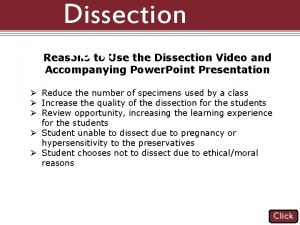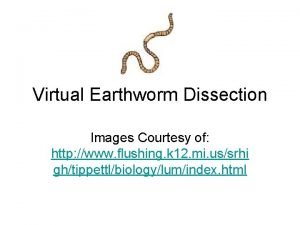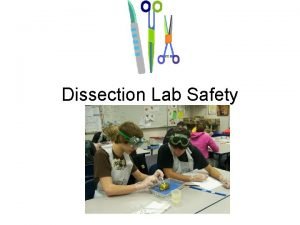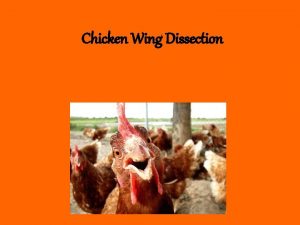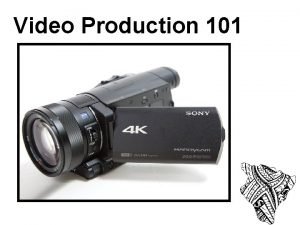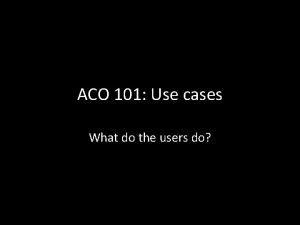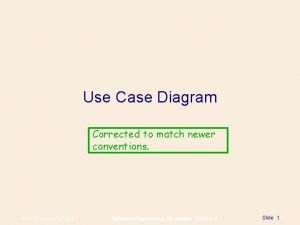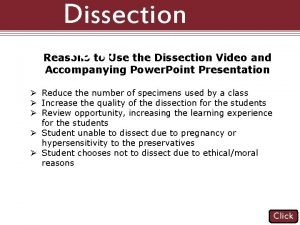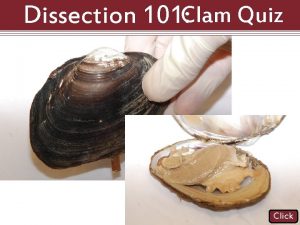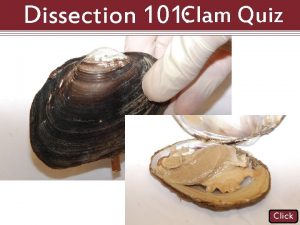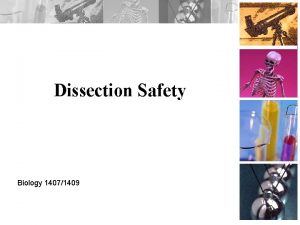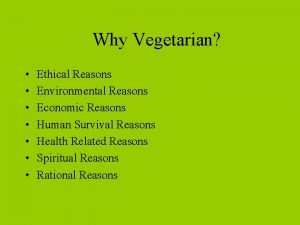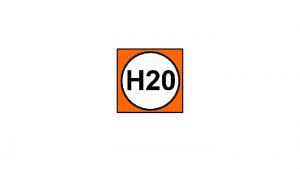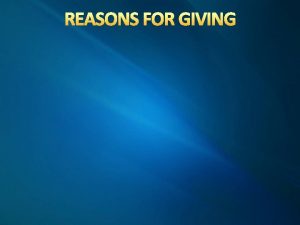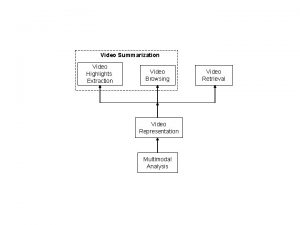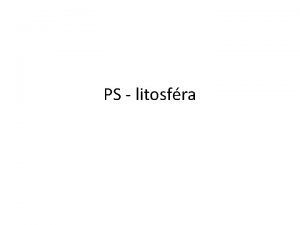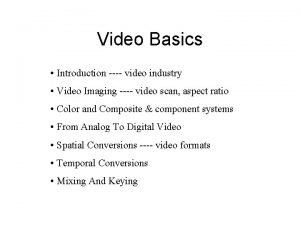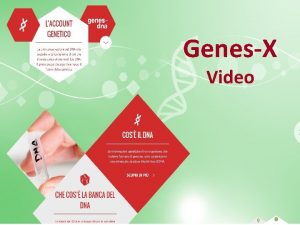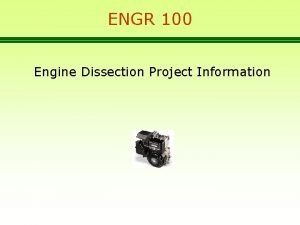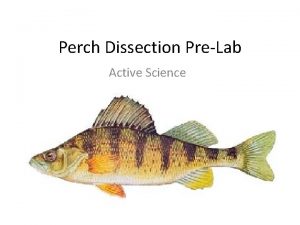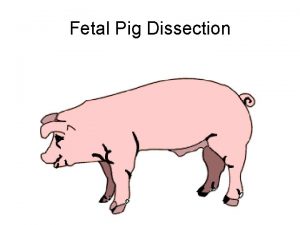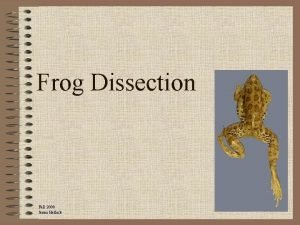Dissection 101 Reasons to Use the Dissection Video
























- Slides: 24

Dissection 101: Reasons to Use the Dissection Video and Accompanying Power. Point Presentation Ø Reduce the number of specimens used by a class Ø Increase the quality of the dissection for the students Ø Review opportunity, increasing the learning experience for the students Ø Student unable to dissect due to pregnancy or hypersensitivity to the preservatives Ø Student chooses not to dissect due to ethical/moral reasons Click

Dissection 101: As an Considerations educator you are responsible for the implementation Safety of the dissection activity described in the video and Ø Age appropriate activity for the children in your care Power. Point. You must have safety procedures and rules Ø Material Safety Data Sheet (MSDS) available for accident established for your classroom and make sure all of the reference students rules to ensure safe environment. Ø Poison follow control the number/phone readily a available Public and Dakota ØSouth Latex Dakota free gloves, eye Broadcasting protection and apron/lab coat State University any way be responsible or liable for Ø Eyewashcannot station, in shower and sink Ø any Sharp instruments (cut away from self and others) injury as a result of performing the described Ø dissection. Sharps and specimen(s) disposal Complete the dissection if you feel it is Ø Encourage students to report all accidents appropriate and safe for your individual class. Ø Basic science laboratory rules (strictly enforced) Have fun and stay safe! Click

Dissection 101: Cow Eye Click

Exterior of the Cow Eye External Orientation Cornea: Anterior protective covering of the eye; transparent allowing light to enter; appears cloudy due to preservation process Side view Essential Fat: White/grey in color; provides protection/cushion Click

Dissection 101: Cow Eye Getting Started Optic nerve Extrinsic muscles Student Cuts: • You. Tube • SDPB Ø Use a scissors or scalpel to remove the excess fat from the eyeball (capsule); always cut away from yourself Ø The extrinsic muscles, which are used to move the eye, should also be removed (appear marbled, similar to the look and texture of a raw steak or roast) Ø Do not remove the optic nerve Click

Dissection 101: Cow Eye Optic nerve, chord-like structure protruding from the back of the eye; carries nervous signal from the retina to the posterior (occipital) region of the brain Click

Dissection 101: Cow Eye Ø Continue using a scissors or scalpel to remove the fat, connective tissue and muscle from the back of the eye Click

Dissection 101: Cow Eye Student Cuts: • You. Tube • SDPB Figure 1 Figure 2 Ø Use the point of a scissors or a scalpel to make an incision through the layers of the eye capsule (similar to figure 1); there are three layers from the exterior: sclera, whitish/grey, continuous with the transparent cornea, choroid, thin dark black layer and the retina, thin greyish/pink layer Ø Use a scissors to dissect the entire circumference of the capsule (see figure 2); do not cut toward the cornea Click

Dissection 101: Cow Eye Vitreous humor: Jelly-like material, provides shape/support for the eyeball; helps hold retina in place Ø Using steady pressure, pull the two sections slowly apart Click

Dissection 101: Vitreous humor removed, retina against the back of the eye Cow Eye Student Cuts: • You. Tube • SDPB Ø Many Using yourthe finger or a forceps, of the jellytimes greyish/pink retina carefully is attachedscrape to the any vitreous like vitreous humor that is attached to from the front of the eye humor, carefully remove/scrape the retina the vitreous humor and lay it on the back of the eyeball. Click

Dissection 101: Cow Eye Retina: Nervous tissue, location of the photo receptors (cones for sharp color vision and rods for night, dark/shaded vision); light energy converted to electrical impulse; the retina is continuous with the optic nerve which leaves the back of the eye carrying the nervous impulse to the brain Click

Dissection 101: Cow Eye Optic nerve Retina Optic disc (blind spot): location on the retina where the retina attaches to the optic nerve, sight does not occur at this location because there are no cones or rods present Click

Dissection 101: Cow Eye Many laboratory books label the fovea centralis/macula, which is the location in eye where the sharpest vision occurs; the fovea centralis/macula is dense with cones and is the location of focus during lighted conditions, like reading; the fovea centralis/macula appears as a depression in the retina, but it is very difficult to find (Note: know the function for the quiz, identification is not required ) Click

Dissection 101: Cow Eye Choroid: Dark layer of the eye, rich with blood vessels; reduces scattering of light and provides nourishment for the eye Many vertebrates like the cow, deer and cat have a tapetum lucidum which is an iridescent, reflective layer found on the choroid; the tapetum lucidum aids in the reflection of light toward the retina, increasing the ability to see at night; the human choroid does not have a tapetum lucidum Choroid shown folded forward in this image Click

Dissection 101: Cow Eye Cornea Sclera: Tough protective outer layer of the eye which gives the eyeball its shape; the white part of the human eye; continuous with the transparent cornea; the sclera has blood vessels (may appear bloodshot); the cornea does not have blood vessels Click

Dissection Cow Eye Anterior Identification 101: Lens Note: Aqueous humor, a transparent fluid produced by the ciliary body is located between the lens and the cornea; the fluid provides shape for and nourishes the cornea and it also provides nourishment for the lens; the fluid will release as the lens is removed Suspensory ligaments: Hold the lens in place, attaches lens to ciliary body Student Cuts: • You. Tube • SDPB Ø Using a dissection probe, carefully remove the lens from the Click anterior of the eye

Dissection 101: Cow Eye Ø Using a dissection probe, carefully remove the choroid, ciliary body, and iris from the anterior of the eye; these structures will be removed as one unit Click

Dissection 101: Cow Eye Cornea: Anterior protective covering of the eye; transparent allowing light to enter; appears cloudy due to preservation process; lacks blood vessels, nourished by aqueous humor; continuous with sclera Click

Dissection 101: Cow Eye Lens: Biconvex structure that focuses light on the retina through a process called accommodation Click

Dissection 101: Far Object Cow Eye Iris Lens Retina Figure 2 Close Object Lens Ciliary Body Retina Figure 1 Muscles of the ciliary body contract toward the lens (Figure 1), resulting in less pull on the lens. The lens bulges to its natural form resulting in the light rays bending more for closer objects. The muscles of the ciliary body relax pulling away from the lens causing the lens to flatten for distant objects (Figure 2). Pupil Click

Dissection 101: Ciliary body Cow Eye Pupil: Opening of the eye, allows light to enter. The diameter of the opening is controlled by the iris. The pupil is the dark center of the eye; the pupil is black because light enters but it does not leave. Iris: Structure of the eye which controls the size of the opening into the eye which is called the pupil. The pupil gets larger when the radial muscles of the iris contract in dim light. The circular/sphincter muscles of the iris contract to reduce the size of the pupil for brighter light. The iris is the colored structure of the human eye. Click

Dissection 101: Cow Eye Microscopic View of the Iris, Ciliary Body and Pupil Anterior view, closest to the cornea Posterior view, closest to the lens Pupil Iris Ciliary body Click

Dissection 101: Cow Eye Review Main Structures Optic nerve Choroid with tapetum lucidum Iris Cornea Lens Pupil Sclera Retina Vitreous humor Click

Dissection 101: Cow Eye Produced by Dakota State University and South Dakota Public Broadcasting
 Dissection 101 sheep heart quiz
Dissection 101 sheep heart quiz Dissection 101
Dissection 101 Dissection 101 sheep heart quiz
Dissection 101 sheep heart quiz Ventral surface of brain labeled
Ventral surface of brain labeled Dissection safety worksheet
Dissection safety worksheet Digestive gland starfish
Digestive gland starfish Chicken wing dissection lab
Chicken wing dissection lab Precipitating factors are internal or external
Precipitating factors are internal or external Cpi training coping model
Cpi training coping model 3 phases of video production
3 phases of video production Video 101
Video 101 Videoyandex
Videoyandex Gravity yahoo
Gravity yahoo Yahoo
Yahoo Digital media primer
Digital media primer Use case 101
Use case 101 Corrected
Corrected How to use viva video step by step
How to use viva video step by step Hình ảnh bộ gõ cơ thể búng tay
Hình ảnh bộ gõ cơ thể búng tay Frameset trong html5
Frameset trong html5 Bổ thể
Bổ thể Tỉ lệ cơ thể trẻ em
Tỉ lệ cơ thể trẻ em Gấu đi như thế nào
Gấu đi như thế nào Tư thế worm breton
Tư thế worm breton Chúa yêu trần thế
Chúa yêu trần thế
